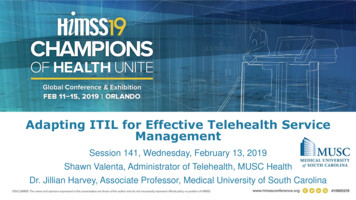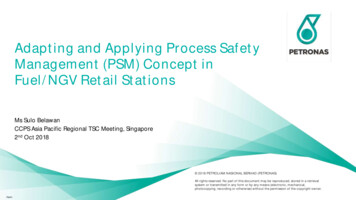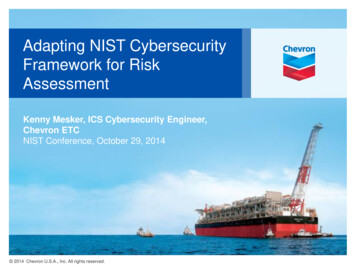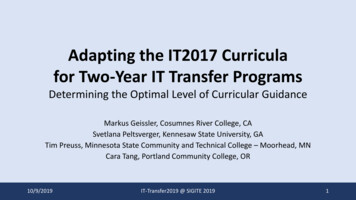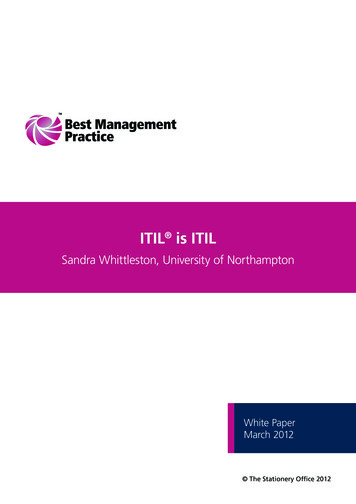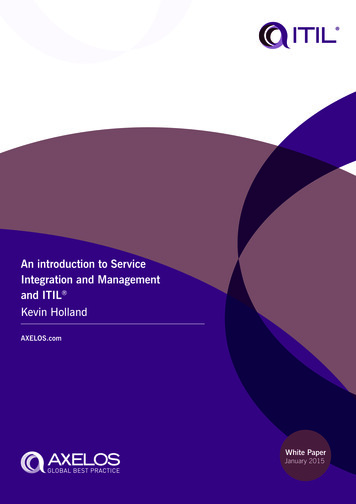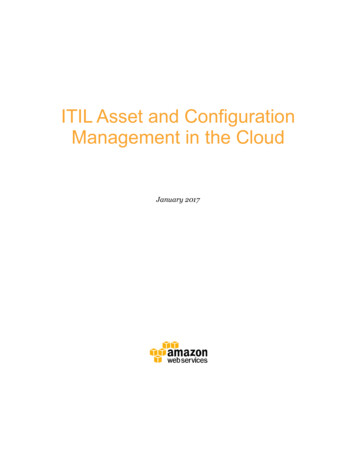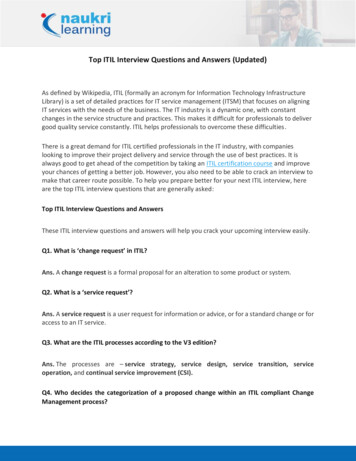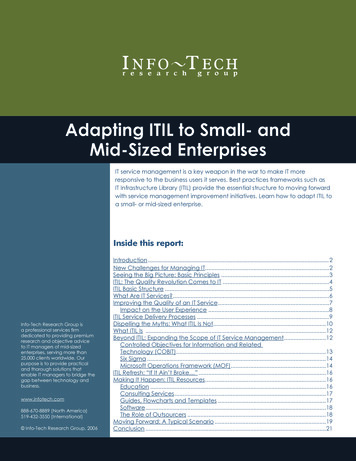
Transcription
Adapting ITIL to Small- andMid-Sized EnterprisesIT service management is a key weapon in the war to make IT moreresponsive to the business users it serves. Best practices frameworks such asIT Infrastructure Library (ITIL) provide the essential structure to moving forwardwith service management improvement initiatives. Learn how to adapt ITIL toa small- or mid-sized enterprise.Inside this report:Info-Tech Research Group isa professional services firmdedicated to providing premiumresearch and objective adviceto IT managers of mid-sizedenterprises, serving more than25,000 clients worldwide. Ourpurpose is to provide practicaland thorough solutions thatenable IT managers to bridge thegap between technology andbusiness.www.infotech.com888-670-8889 (North America)519-432-3550 (International) Info-Tech Research Group, 2006Introduction .2New Challenges for Managing IT.2Seeing the Big Picture: Basic Principles .3ITIL: The Quality Revolution Comes to IT .4ITIL Basic Structure .5What Are IT Services?.6Improving the Quality of an IT Service .7Impact on the User Experience .8ITIL Service Delivery Processes .9Dispelling the Myths: What ITIL Is Not.10What ITIL Is .12Beyond ITIL: Expanding the Scope of IT Service Management .12Controlled Objectives for Information and RelatedTechnology (COBIT).13Six Sigma .14Microsoft Operations Framework (MOF).14ITIL Refresh: “If It Ain’t Broke ” .16Making It Happen: ITIL Resources.16Education .16Consulting Services .17Guides, Flowcharts and Templates .17Software .18The Role of Outsourcers .18Moving Forward: A Typical Scenario .19Conclusion .21
Adapting ITIL to Small- and Mid-Sized EnterprisesINTRODUCTIONInformation Technology Infrastructure Library (ITIL) has taken the IT world bystorm. With the pool of ITIL-certified professionals growing at 30% per year, this isone of the fastest-growing phenomena in IT. Enterprises of all sizes are learning toreap the benefits of this powerful approach. However, in the excitement, manyindividuals see ITIL as the answer for whatever IT problems they are experiencing.This bandwagon effect has led to failed efforts and wasted resources.At the most fundamental level, ITIL is a set of best practices that helps ITenterprises provide reliable and consistent service to end users at a cost thatthe enterprise can afford. As IT has evolved, a number of complementaryframeworks have emerged, but the basic principles of quality improvement haveremained constant, and they apply to enterprises of all sizes.These basic quality principles are the focus of this Info-Tech Research Report.We’ve also made an effort to clarify the most frequently misunderstood aspectsof ITIL, and to explain the relative role of other bodies of knowledge, such as theMicrosoft Operations Framework (MOF) and the COBIT governance framework.NEW CHALLENGES FOR MANAGING ITSophisticated IT technology is no longer the preserve of large governments andmultinationals. The last decade has seen the downsizing of enterprise applicationssuch as Customer Relationship Management (CRM) and Enterprise Resource Planning(ERP), which has brought “big company” functionality within reach of the averageenterprise. Furthermore, high-speed communications, mobile technologies, and lowcost data storage are helping small- and mid-sized enterprises (SMEs) leverage thesetechnologies to enter global markets, virtualize their offices, monitor business activity inreal time, and communicate better with customers.However, “big IT” power begets “big IT” problems. The average SME today ismanaging an increasingly complex array of IT assets, and this is making it harderto manage the overall quality of IT, as well as to understand and control the costs.Many decision makers feel that IT is getting vastly out of control.To address this, many enterprises are taking a serious look at what a decade agowas only contemplated in very large IT departments – IT Service Management(ITSM). ITSM involves imposing a formal structure on IT that allows it to bemanaged cohesively. This is not unlike assigning a management structure to alarge group of people, or a process structure to a factory.Essentially, ITSM allows environments to be managed with a focus on output;that is, what users and stakeholders are actually getting out of IT. This model ismanaged on two fronts:2 2006 INFO-TECH RESEARCH GROUPTOC
Adapting ITIL to Small- and Mid-Sized Enterprises The measurement and continuous improvement of IT delivery from theend-user perspective. Improved alignment between IT and the business.Success in this endeavor requires enterprises to get a solid handle on the diverseinfrastructure upon which IT rests. Implementing a service delivery model is nosmall undertaking; however, the IT industry has been very active in addressing thisproblem since the early 1980s. This is what ITIL, and the community that supports it,is all about.SEEING THE BIG PICTURE: BASIC PRINCIPLESMost enterprises don’t manage IT cohesively. Instead, IT is seen as the vague endresult of a collection of software packages, laptops, cables, telecom services,servers, and network devices. This piecemeal approach means that the totaloutcome of IT is never put under the microscope.Taking ownership for the user experience is where service managementbegins. Under service management rules, everybody who affects the customerexperience is on the same team. If the ERP system is unavailable to the shipperon the loading dock, it doesn’t matter if it’s a database problem, a disk problem,or a network problem. This is an interruption of service that affects the shipper’sability to do his or her job. As far as IT is concerned, it’s everybody’s problem.This focus is not unique to ITSM. In fact, the principles in ITIL and other frameworksare derived from the same quality methods that transformed industry in thesecond half of the 20th Century. The same quality process that ensures that themoon roof on a Toyota or Ford doesn’t leak can also be used to ensure that auser’s e-mail doesn’t crash when downloading a large document from a Web site.Quality methods of this type are characterized by the following: The use of feedback loops to create ongoing improvement towardsmeasurable goals. The pursuit of quality not as an arbitrary technical goal, but as an entityexperienced by the customer. Teaming to break down silos and functional barriers and create a unifiedapproach.One of the classic hallmarks of quality methods is the Shewhart circle, illustratedbelow. Named after its inventor, the American statistician Walter Shewhart, thissimple model has become the paradigm for continuous quality improvement.3 2006 INFO-TECH RESEARCH GROUPTOC
Adapting ITIL to Small- and Mid-Sized EnterprisesQuality Improvement Cycle1. Plan. Design or reviseproduct elements to improveresults.4. Act. Adjust the planbased on feedback receivedduring the check process. 3. Check. Determine whetherdesired results were achievedfrom customer perspective.2. Do. Implement the plannedchanges or interventions asindicated.Figure 1. Quality standards are detailed and complex, but they are based on asimple model for continuously improving quality.ITIL: THE QUALITY REVOLUTION COMES TO ITITIL was developed in the U.K. in the 1980s in an effort by the government toimprove its management of IT. Although the term “Library” makes ITIL soundtheoretical and academic, it is everything but. Fundamentally, it is a collection ofbest practices for managing IT, collected from sources all over the world.ITIL has become a de facto global standard. Global IT giants such as IBM, HP, andEDS have standardized their service operations according to ITIL. Over 100,000individuals are ITIL-certified, and that number is growing rapidly, swelling the ranksof local ITIL enterprises in every corner of the globe.To support this best practice approach, the IT Service Management Forum(itSMF), the governing body for ITIL, has thousands of members who sharebest practices on a worldwide basis. This is accomplished through seminars,conferences, newsletters, information databases, and participation in educationand certification processes. itSMF also seeks to improve standardization, andinvolves itself with standards bodies such as ISO and the British Standards Institute(BSI). In connection with this association, BSI has recently introduced BS15000,an ITSM standard based on ITIL practices. Another standard, ISO20000, will bringstandardization of ITIL processes to an international level. Both standards will allowIT departments to be independently audited for the successful implementation ofITIL-based processes.4 2006 INFO-TECH RESEARCH GROUPTOC
Adapting ITIL to Small- and Mid-Sized EnterprisesITIL BASIC STRUCTUREITIL allows for the establishment of a suite of individually owned processes that,when combined, impose a comprehensive and balanced structure on all ITendeavors. The basic core processes are illustrated below:The BusinessChangeManagementService seManagementServiceDeskIT Svc ContinuityManagementCapacityManagementService DeliveryService SupportIT UsersFinancialManagementFigure 2: Basic ITIL ProcessesTwo salient features of this management structure should be noted.1. The Service Desk plays a central role. All feedback about theperformance of the IT systems comes through this single point of contact.The services desk also owns the documentation process. As a result, theservice desk serves as the hub for the information flow for all aspects ofthe service management process.2. The services are divided into two categories. One is dedicated toimproving the quality of service for end users. The other is dedicatedto measuring and controlling the cost and quality of IT from a businessperspective. The two are designed to work together in a balanced,complementary fashion.5 2006 INFO-TECH RESEARCH GROUPTOC
Adapting ITIL to Small- and Mid-Sized EnterprisesWHAT ARE IT SERVICES?Best practice frameworks, and ITIL in particular, use a service management modelto define what is delivered to end users and to the business. We see this approachwhen we buy telephone, cable TV, Internet, and voicemail services. What is newhere is the delivery of all of IT within a service framework. An important footnote isthat IT services cannot be as generic as their telecommunications counterparts,but must be customized.A key requirement for an IT service is that it is easily identifiable. It doesn’t makesense, for example, for a user to be evaluating a service such as “MicrosoftWindows Operating System” when this is not an entity that is tangible for theaverage user. “Corporate E-mail,” on the other hand, is easily understood. Table 1gives examples of typical IT services that might be found in an vice of end-useraccounts using MSOutlook and MSExchange.Desktop hardware, MS Outlook client, MSExchange mail server, storage devices,security software, automated monitoring,network devices, virus protectionsoftware, SPAM control, 24/7 help deskfacility, onsite service staff.Wireless PDAServiceHosting and qualitycontrolled deliveryof BlackBerrywireless networkapplications.Client device (e.g. RIM BlackBerry),wireless carrier service, server hardware,application hosting, automatedmonitoring, network devices, storage,virus protection software, spam control,24/7 help desk facility, onsite service staff.ERPApplicationHosting and qualitycontrolled deliveryof Navision ERPapplication.Application server, integration server,storage devices, security software,automated monitoring, network devices,virus protection software, spam control,24/7 help desk facility, onsite service staff.Each service has many components, and each of them have much incommon – they all use the corporate network, a desktop device, a back-officeinfrastructure, and other IT amenities. There are also patches, plug-ins, and otherelements that are unique. However, when it comes to delivering corporate email, the user shouldn’t have to worry about any of this, just as the owner of a cardoesn’t have to be concerned with wheel bearings and engine parts. Similarly,the business stakeholder should have easy access to information such as whate-mail is costing per user, or what the cost might be of improving that service.Being able to continuously improve the service, and assess the cost of making theservice more reliable, is where best practices come in.6 2006 INFO-TECH RESEARCH GROUPTOC
Adapting ITIL to Small- and Mid-Sized EnterprisesIMPROVING THE QUALITY OF AN IT SERVICEITIL Service Support processes, shown in the left quadrant of Figure 2, provideenterprises with common tools for continuous improvement of IT services. Amajor factor is consistency. It would be impossible to make any headway if themeasurement methods changed every time a problem occurred. The process ofcontinuous improvement has to be universal whether it involves network issues,application issues, or hardware issues.The basic Service Support processes are described in Table 2 below:ITIL ProcessDescriptionConfigurationManagementCreation and maintenance of a database of all ITconfiguration items, their relationship with other items,and their proper state.IncidentManagementReceiving, recording, and classifying user reports ofmalfunctions, primarily received through the help desk.ProblemManagementAnalysis of incidents to uncover patterns of repetitionthat might indicate a common root cause. Positiveconclusion results in a Request for Change (RFC), andthe cycle repeats.ChangeManagementResponse to and action upon requests for change.Process includes solution evaluation and design, riskanalysis, prioritization, approvals, and feasibility testing.ReleaseManagementSequence of events for rolling out a change to theuser environment in order to minimize disruption,prevent errors and loss of data, and maintain properdocumentation.As an example, the ITIL processes shown above could be used to resolve asoftware version conflict. Suppose that a number of users have reported throughthe Service Desk that they are occasionally unable to open .PDF (AdobeAcrobat) files downloaded from the Internet. Here are the steps that would betaken to resolve the issue:1. The repeated incidents, as captured by Incident Management, areforwarded to Problem Management for further investigation.2. Input from users is analyzed through the Problem Management processto determine the root cause, resulting in a proposal for a configurationchange.3. Change Management evaluates and tests possible changes, and comesup with the best solution. In this case, it might be the implementation of asoftware patch, or even an upgrade to a new version.4. Release Management handles the rollout, ensuring that the change ismade in the least disruptive fashion.7 2006 INFO-TECH RESEARCH GROUPTOC
Adapting ITIL to Small- and Mid-Sized Enterprises5. Incident Management keeps a close watch on the situation to ensurethat the change has truly eliminated the problem, and that users are nolonger having difficulty.These processes flow in a cyclical fashion, following the classic Shewhart Circleparadigm, as illustrated in Figure 3 below.Evaluate proposed fixaccording to ChangeManagement Process(Plan)Documentaccording toConfigurationManagementProcessAnalyze historyaccording to ProblemManagement Process(Act)Rollout fix accordingto ReleaseManagement Process(Do)Monitor user reactionaccording to IncidentManagement Process(Check)Figure 3. Using ITIL processes to implement a software patch to resolve a versionconflict.As the diagram illustrates, the pattern applies to all service interactions. Thegoal is to continuously improve the quality of a recognizable service, such asCorporate E-mail. The “engine” for the process is continuous user feedback,which constantly drives improvement. The same process flow will take place forany defect in the service, regardless of whether the root cause is attributable tonetworks, hardware, software, an external service, or even user training.IMPACT ON THE USER EXPERIENCEITSM raises the bar when it comes to service quality, and it does so in a visible andrecognizable way. User benefits are delivered in the following ways:8 Overall quality is improved by systematically removing defects. If thesame incident keeps re-occurring, this is an indication that there is anunderlying problem that needs to be resolved. ITIL provides the disciplineand the structure to identify and remove problems from the system,creating a lower volume of disruptions and a superior user experience. Users are respected. Quality criteria are defined in user terms, not inIT terms that the user can’t understand. User input is not treated as anannoyance, but is a valued part of the quality process. 2006 INFO-TECH RESEARCH GROUPTOC
Adapting ITIL to Small- and Mid-Sized Enterprises Users enjoy consistent treatment from IT. Incidents are always handled thesame way, regardless of the root cause of the problem. With all IT peoplereading off the same script, a user will not be given one version of thestory from one person and another from a different person. There is broad agreement of what constitutes a legitimate problem. If anumber of users are experiencing a difficulty, this could be justificationfor a change. At the very least, it might be an indication that training isrequired, or a feature is impractical for use and should be disabled.ITIL SERVICE DELIVERY PROCESSESIT is not just about making users happy – IT investments also have to make businesssense. In other words, if there’s a need to reduce disruptions of the ERP system inshipping, the CFO needs to know what that is going to cost in order to decidehow much of a safety factor the enterprise can afford.In order to achieve this, a disciplined and structured approach is required. As isthe case with Service Support, a set of processes that are clearly delineated, andyet interactive, is required. The creation of a disaster plan is a good example.In this case, Business Continuity Management will identify the IT functions thatare absolutely vital to the business, but will need the assistance of CapacityManagement to understand what the resource requirements would be to restorethese functions in a recovery situation.The processes are described as follows:9 Service Level Management is the ultimate goal of ITSM. As a process,it deals with the relationship between IT and its stakeholders. Servicelevels are defined, negotiated, reviewed, and tested according to aService Level Agreement (SLA). Also included is the creation of a ServiceCatalogue, which comprises of all the services that an IT department isable to deliver. Availability Management can be roughly defined as freedom fromoutages or other disruptions. The Availability Management process coversthe creation of a comprehensive availability plan, and the monitoring ofIT systems to ensure that the goals of this plan are met. Special attention ispaid to systems that support vital business functions. Financial Management provides a plan that ensures that the financialresources are in place to operate IT according to requirements asoutlined in the other areas. This includes the budgeting of IT, assessmentof real versus projected costs, and performance monitoring. It should benoted here that the Financial Management process does not providefor a financial audit of IT, nor does it provide direct correspondence withSarbanes-Oxley and other legislation. 2006 INFO-TECH RESEARCH GROUPTOC
Adapting ITIL to Small- and Mid-Sized Enterprises Capacity Management tracks and manages the resources being usedto satisfy the needs of the enterprise. These include storage capacity,disk space, CPU capacity, and personnel. The process also includes thecreation and maintenance of a Capacity Plan. Business Continuity Management protects the business againstdamage due to the temporary loss of IT systems. Commonly known asdisaster recovery, BCM covers vulnerability and risk assessment, impactassessment, creation and testing of a recovery plan, staff education, andreview of other processes that could impact on resiliency in case of adisaster. Security Management is a supplementary process that was recentlyadded to ITIL. This process protects against the loss or compromise ofcorporate assets such as data. This includes categorization of assets,assignment of security levels, creation and maintenance of a securityplan, and monitoring of security-related incidents.ITIL Service Delivery processes provide the following benefits: The establishment of an optimum level of service within specific costconstraints. The design and measurement of a service according to specificparameters that directly impact a business, such as Key PerformanceIndicators (KPIs). Alignment of service quality with corporate incentive programs. A clear picture of the IT risks to which an enterprise is exposed. ROI and TCO analysis of IT investments.DISPELLING THE MYTHS: WHAT ITIL IS NOTAs with many trends, myths abound when it comes to ITIL. Because ITILinvolves some approaches that are truly new to many enterprises, it is easy tomisunderstand what ITIL is all about. There is also a lot of hype around the subject.This section will shed some light on the most frequently misunderstood areas.#1: ITIL Is Not Something You Can Implement Out of the BookThe relationship between the content of the ITIL books and the operation of anIT department is not simply a direct one. In fact, there is a three-layer structure,as illustrated below. ITIL definitions and guidelines actually become the basis ofspecific processes that are developed in an enterprise.10 2006 INFO-TECH RESEARCH GROUPTOC
Adapting ITIL to Small- and Mid-Sized EnterprisesOperationsStaffDelivery of ITServicesGovernedByProcessDesignersIT ProcessesBasedOnITIL BooksITIL Principlesand DefinitionsFigure 4: How theory meets practiceThis distinction is important, because the middle layer – the design of processesbased on ITIL – can be very costly and time-consuming. In fact, this middle layer isthe biggest hurdle to implementing ITIL.#2: ITIL Is Not a StandardVendor claims of “ITIL compliance” for everything from software to vendorprocesses give the impression that ITIL is a standard. However, this is not the case.ITIL is a set of best practices that can be used as the user sees fit. In the strictestsense of the term, there is no such thing as ITIL compliance.However, there are now emerging standards based on ITIL principles. BS150000(BS stands for “British Standard”) was developed in the U.K., and is an auditablestandard for ITIL processes. ISO has stepped into the ring with ISO20000, which willhave an international scope.#3: ITIL Is Not a Governance FrameworkGetting IT under control with ITIL is an important step in meeting the requirements ofSarbanes-Oxley and other legislation. However, ITIL does not address governancein a comprehensive way and cannot be used on its own to ensure Sarbanes-Oxleycompliance. However, ITIL maps well with COBIT, the de facto North Americangovernance framework, which is discussed later in this document.#4: ITIL Does Not Cover All Aspects of Today’s IT EnvironmentsITIL is based on a highly centralized IT model that existed in 1980. Since thattime, we have seen revolutionary changes in IT, including the advent of desktop11 2006 INFO-TECH RESEARCH GROUPTOC
Adapting ITIL to Small- and Mid-Sized Enterprisescomputing, networking, client/server computing, and the Internet. MicrosoftOperations Framework (MOF), which is described below, is an example of a bodyof knowledge that builds on ITIL to address these changes.#5: ITIL Is Not an “All or Nothing” PropositionThe interactive nature of ITIL processes implies that the entire framework has tobe in place for benefits to accrue. This is not the case. Many enterprises benefitfrom implementing only one or two ITIL processes. This is especially true for smallerenterprises.#6: ITIL Is Not a ReligionMany CIOs may be looking for a magic bullet to end their IT chaos, but blindlyfollowing ITIL in hopes that everything will fix itself is doomed to failure.WHAT ITIL ISThe success of ITIL is based on its applicability to a wide range of IT scenarios. Thefollowing observations are key: ITIL is scaleable. ITIL principles can be used to create processes forenterprises of all sizes. Even a one-person help desk can use ITIL to recordconfigurations, track incidents, and manage escalations. ITIL is flexible. One of the maxims of the ITIL community is “adopt andadapt.” This means take the ITIL principles and use them as required in theenterprise. ITIL is all about teamwork. Enterprises of any size that embrace ITIL needto break down barriers between different stakeholder groups. Fingerpointing, for example, between the database people and the networkpeople cannot be had when user productivity is on the line. ITIL, at themost fundamental level, gets everybody working towards the same goal. ITIL is evolving. ITIL is currently being re-written through the ITIL Refreshproject. ITIL works well with other frameworks. In keeping with the “adopt andadapt” philosophy, ITIL maps well with other bodies of knowledge.BEYOND ITIL: EXPANDING THE SCOPE OF ITSERVICE MANAGEMENTAs IT has evolved, the field of ITSM has expanded beyond ITIL’s original scope,encompassing the following new areas: 12Network management and the establishment of end-to-end services. 2006 INFO-TECH RESEARCH GROUPTOC
Adapting ITIL to Small- and Mid-Sized Enterprises Application management, covering the increasingly complex nature ofdistributed environments. Software management, satisfying the need to manage software quality ina continuously changing environment. Security management, addressing the increased risks to IT systems resultingfrom distributed architectures and the Internet. Improved financial management, spurred on by the vastly complexarray of costs and business benefits that have arisen from recent ITdevelopments.At least a dozen standards have emerged that support this expanded roleof ITSM. These are complementary in nature, and are supported by the ITSMcommunity through itSMF. It is beyond the scope of this document to look at all ofthem. Instead, we will focus on the three that are most likely to matter to the SME:COBIT, Six Sigma, and MOF.CONTROLLED OBJECTIVES FOR INFORMATION AND RELATED TECHNOLOGY(COBIT)Many enterprises will have run into COBIT before considering ITIL. If SarbanesOxley compliance is on the agenda, COBIT is not an option but rather arequirement.COBIT was published and is maintained by the Information Systems Audit andControl Foundation (ISACA) and the IT Governance Institute. Like ITIL, COBIT isin the public domain. COBIT is commonly used alongside ITIL to formalize theaccountability links between various aspects of IT and the financial governancestructure of an enterprise.COBIT puts emphasis on the factors that matter most: risk management, security,consistency of data, and cost control. To this end, COBIT establishes 34 controlobjectives, each linked to a number of specific activities. These are all tiedtogether by means of a common control framework, supported by a number ofmanagement guidelines.Many of the control objectives in COBIT are present in ITIL. Therefore, usingthem both is not an “either or” proposition – the processes in ITIL will help, nothinder, adoption of COBIT. There is some overlap, particularly with regard to ITIL’sFinancial Management function, but this is easily manageable. What COBIT addsis much more detail on the financial and management side, and interfaces wellwith formal accounting and audit principles.COBIT, in spite of its relation to formal audits, is an “adopt and adapt” framework. As acase in point, the IT Governance Institute has published COBIT online to make it easyfor users to adapt it for their own enterprise. Furthermore, and of special interest toSMEs, there is a version cal
ITIL was developed in the U.K. in the 1980s in an effort by the government to improve its management of IT. Although the term “Library” makes ITIL sound theoretical and academic, it is everything but. Fundamentally, it is a collection of best practices fo
